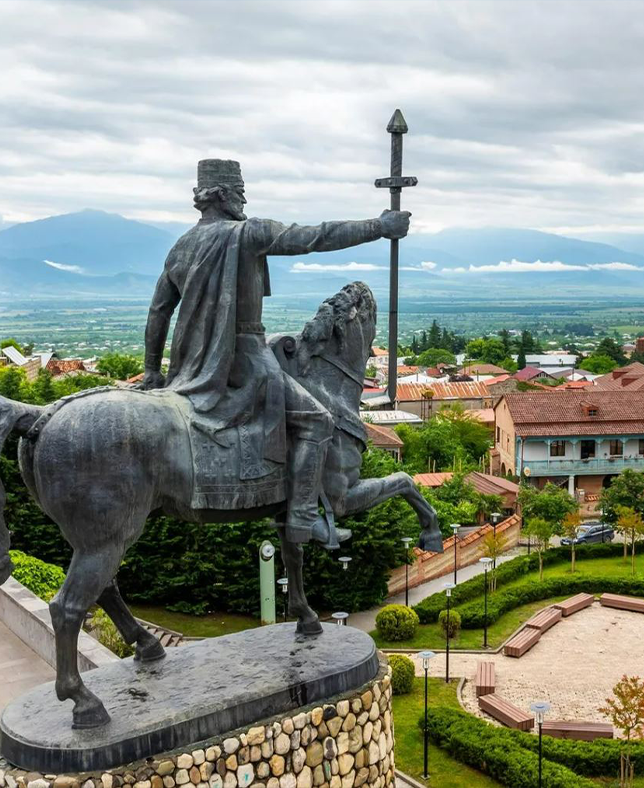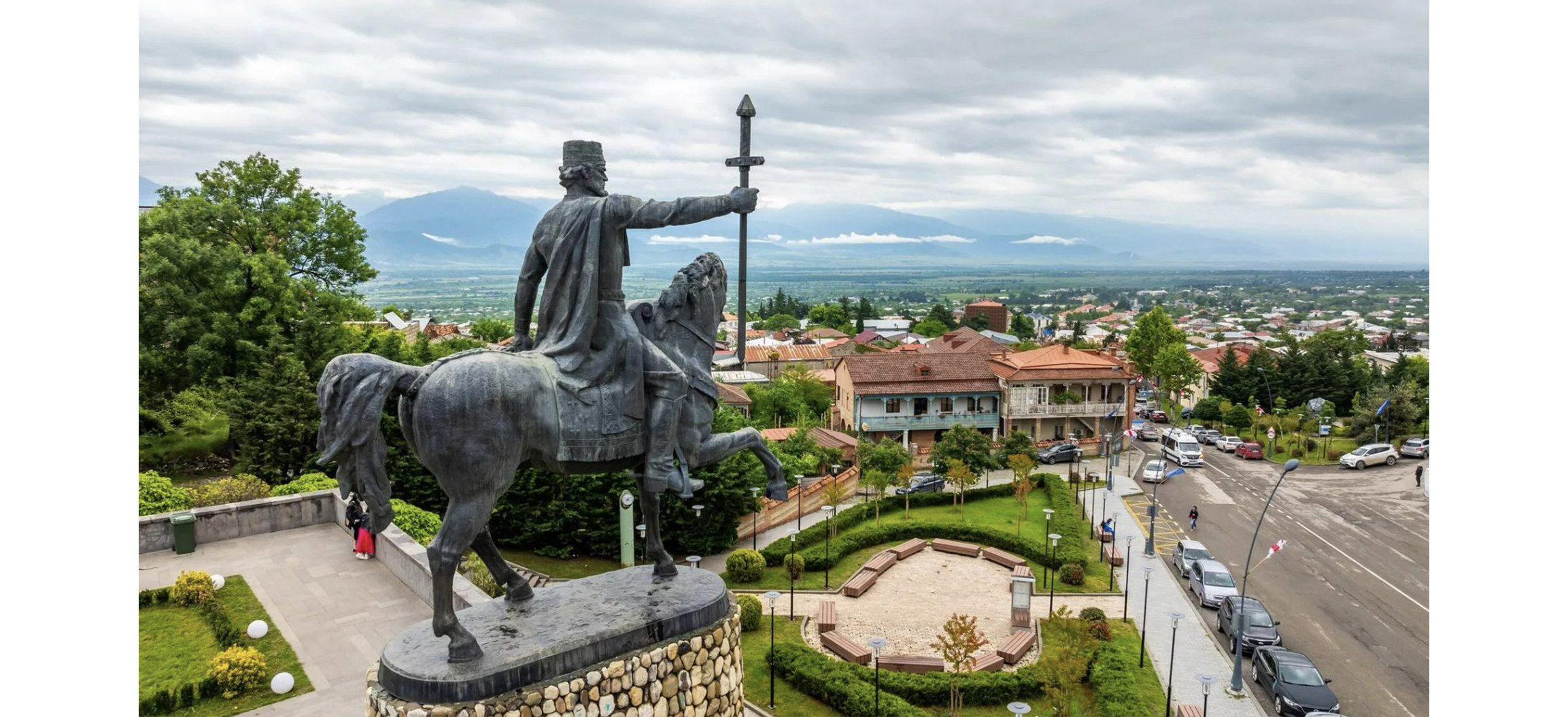
Feel free to add tags, names, dates or anything you are looking for


King Erekle was a son of King of Kakheti Teimuraz II. King Teimuraz II ruled Kakheti from 1709 to 1744, first as a governor, and then as King of Kartli from 1744. Interestingly, Teimuraz’s father, Erekle I (1688-1709), and brother, Constantine II (1722-1732), were not distinguished by their devotion to Christian religion or high ideals. Indeed, their biographies show that power was more important to them than the well-being of their subjects or peaceful relations with the neighboring rulers. Yet, it appears that, unlike his father and brother, Teimuraz was firmly determined to defend Christianity and establish an alliance with Russia so as to be able to defend his kingdom against its Muslim neighbors. Erekle II’s mother, Tamar, was the daughter of King Vakhtang VI (1716-24), so the prince, born in Telavi on November 7, 1720, united both the Kartlian and Kakhetian branches of the Bagrationi dynasty of Eastern Georgia.
.jpg)
King Teimuraz II
The young prince came of age during a turbulent period for Kartl-Kakheti. His father made every effort to protect the country, though with varying degrees of success. Erekle got his first true test in battle in 1735, when the Georgian army under his command defeated the Dagestani tribesmen, the Lezgins, who had invaded Kiziqi, in the south-eastern part of the Kakhetian kingdom. According to legend, it was after this battle that the people nicknamed Erekle ‘Little Kakhi’ (‘Kakhi’ or ‘Kakhetian,’ since he ruled Kakheti).
.png)
King Erekle II
Greater challenges soon followed. In 1737, Erekle accompanied his father to Iran to participate in a military campaign to India, organized by the powerful ruler of Iran, Nader Shah Afshar (1737-47). There, Teimuraz, together with his young son, managed to secure Nader Shah’s approval to rule as Christian monarchs. The Shah agreed, and, in 1745, King Teimuraz was annointed in Mtskheta according to a Christian rite. Teimuraz ruled Kartli, while the young Erekle became ruler of Kakheti.
One of the greatest internal challenges the two kings faced was Georgia’s feudal structure. Unlike in Europe, absolutism never fully developed in Georgia. The powerful noble families persistently resisted any efforts to centralize royal authority. However, the kings of Kartli and Kakheti took appropriate measures to limit their political influence: in 1743-1744, they abolished the principalities of Ksani and Aragvi. Teimuraz and Erekle were able to subjugate not only the Georgian princes, but also the neighboring Muslim khanates, which strengthened the position of Kartli-Kakheti as the leading power in the Caucasus.
.png)
Nader Shah
This growing strength was evident in their military campaigns. In 1751, Erekle led Georgian forces to a decisive victory over Azat Khan Afghan, a Pashtun warlord seeking to dominate Iran, who had launched an incursion into Transcaucasia. In 1752, Erekle also defeated one of the main contenders for supremacy in Transcaucasia - Haji-Chalab Kurban-Oglu (1703-1755).
Despite these victories, the stability of Kartl-Kakheti remained fragile. Following the death of Nader Shah (1747), Iranian suzerainty over Georgia held only a nominal character: the main threat now came from the warlords of Dagestan. These Lezgin raids became one of the most severe and persistent problems for 18th-century Georgia. Between 1755 and 1757, Erekle faced several large-scale invasions, but was able to successfully repelled the forces of Dagestani leaders such as Nursal Beg and Kokhta Beladi.
.jpg)
Lezgins
To put rest to the constant instability, the Georgian kings sought an alliance with the Russian Empire. For this purpose, King Teimuraz traveled to Russia in 1760, where he died in 1762. After his father’s death, Erekle became the king of the united kingdom of Kartli and Kakheti. Although Teimuraz’s mission to Russia had not yielded the desired results, Erekle continued his attempts to establish an alliance with Russia, although it is clear from various sources that Russia was not a desirable ally for Erekle. As Russian colonel Burnashov wrote, the main goal for Erekle was to transform the Kingdom of Kartl-Kakheti into a European state: his ideal allies were not Orthodox Russia, but the Western European powers. It was only after his diplomatic efforts with Europe were systematically disrupted, largely due to Russian interference, that Erekle turned north once again. This shift was driven not by loyalty or cultural affinity, but by geopolitical necessity in an increasingly desperate situation.
Despite ongoing external threats, King Erekle remained deeply committed to the internal development of Kartl-Kakheti. In his cultural activities, he was provided with invaluable assistance by his cousin, head of the Georgian Church Catholicos Anton I (1744-1756/1763-1788). Anton I and his circle of students played a central role in translating a wide range of literature - philosophical, theological, natural science, etc. - into Georgian.
King Erekle also prioritized the economic modernization of the kingdom. For this purpose, he founded sugar, glass, wool and weapons factories, and actively encouraged the development of mining. Erekle restored the printing press and mint, and also carried out a judicial reform that was much needed within the kingdom at the time.
By the early 1760s, the Kingdom of Kartl-Kakheti had achieved some stability. The military-political, economic, cultural and social reforms carried out by Erekle had strengthened the dominant position of the kingdom in Transcaucasia. In 1765, he uncovered and crushed a conspiracy led by Paata Batonishvili, the son of Vakhtang VI, eliminating a significant threat to the royal authority and consolidating his rule.
With his internal position more secure, Erekle turned his attention outward. He sought to leverage Russia’s growing ambitions in the Caucasus to Georgia’s benefit. While the relations of the Western European countries with the Ottoman Empire were mainly peaceful, Russia was aggressively advancing in the Balkans, the Black Sea and the Caucasus (although, at that stage, it was paying relatively little attention to the Caucasus). Erekle saw the looming war between the Russian and Ottoman empires as a potential opportunity for small regional states like his own. In addition to the fact that this opportunity implied an alliance between the Russian Empire and Kartl-Kakheti and, consequently, guarantees of security for Kartl-Kakheti, Erekle also saw in this war an opportunity to return the Childir Eyalet, or Samtskhe-Saatabago - an administrative unit of the Ottoman empire which comprised the Georgian lands occupied by the Ottomans.
The Russo-Ottoman War broke out in 1768, and a Russian army under the command of the German general Gottlieb Totleben was dispatched to Transcaucasia. Erekle welcomed the Russian military presence with high hopes. However, these were soon dashed. General Totleben’s arrogant and misguided behavior severely damaged Georgian-Russian relations. Although Erekle defeated the Ottomans in the Battle of Aspindza in 1770, he did not achieve any real results. General Sukhotin, who was sent after Totleben, was also unable to improve the situation. Thus, the Russo-Ottoman War of 1768-1774 did not end with the desired results for the Kingdom of Kartl-Kakheti.
The 1770s brought renewed challenges. Erekle faced further conspiracies against his rule and continued incursions by the Lezgins, which required constant military vigilance. Yet, the most important event for Erekle in the Middle East was the death of the Iranian ruler, Kerim Khan (1751-1779). Over the decades, Erekle had developed an excellent relationship with Kerim Khan, from which the Georgian king received great political benefits: in particular, Iran no longer oppressed Kartl-Kakheti, being instead content with merely a formal recognition of its supremacy over Eastern Georgia. This favorable balance of power collapsed after Kerim Khan’s death. In the ensuing chaos, Agha Mohammad Khan, founder of the Qajar dynasty, rose to power in Iran. Unlike his predecessor, Agha Mohammad Khan viewed Erekle’s pro-Russian orientation with suspicion and alarm. His ascent marked the beginning of a new and perilous chapter for Kartli-Kakheti, as tensions in the region began to escalate once again.
.jpg) f
f
Agha Mohammad Khan Qajar
After yet another failed attempt to establish ties with Western Europe, Erekle again turned to Russia. This time, the Russian Imperial Court deemed the moment opportune and agreed to formalize relations with the Kingdom of Kartl-Kakheti. This gesture was a treaty of protection, which was signed on July 24, 1783. According to the treaty, named the Georgievsky Treaty, King Erekle II recognized the supremacy of the Russian Emperor, followed the will of the Russian Emperor in foreign policy, yet maintained internal autonomy. Russian troops were stationed in Georgia as part of the treaty’s provisions.
.jpg)
The Treaty of Georgievsk
However, the signing of the treaty soon proved ineffective in practice. The Russian military presence was insufficient to protect Kartli-Kakheti from invasions. When Suleiman Pasha attacked in 1784 and Omar Khan in 1785, Russian forces failed to intervene decisively, and, before long, they withdrew from Georgia altogether. Erekle was thus forced to settle relations with the Ottomans in order not to create an additional threat to the kingdom.
This fragile diplomatic balancing act also influenced Erekle’s domestic decisions. In 1789, when a delegation from Western Georgia offered him the throne of Imereti, an act that would have effectively unified Georgia, Erekle declined. The danger of unification lay in provoking Ottoman retaliation. According to the Treaty of Amasya of 1555, Georgia was divided between the Ottomans and Iran (Western Georgia went to the Ottomans, and Eastern Georgia to Iran): the unification of Georgia would have led to aggression from the Ottoman empire, still militarily dangerous despite their decline. Erekle feared that such a step could lead to devastating consequences for the fragile kingdom.
Russia had effectively abandoned Erekle to Iran. Agha Mohammad Khan Qajar, frightened by the Russian invasion of Transcaucasia and angry with the old Georgian king, invaded Kartl-Kakheti in 1795 to punish the Georgians. After several days of bloody fighting, Agha Mohammad Khan captured Tbilisi on September 11, inflicting catastrophic destruction on the city. Yet he did not consolidate his gains; two years later, in 1797, he was assassinated by his own men, preventing a second invasion.
.jpg)
The Palace of King Erekle in Telavi
.jpg)
The city of Telavi
King Erekle lived for another three years after the fall of Tbilisi. Despite a lifetime of struggle to strengthen the Kingdom of Kartl-Kakheti, by the end of the 18th century, the kingdom was weakened, though not to the extent Soviet historiography portrayed it to justify the Russian annexation of Georgia. Erekle spent the last days of his life in Telavi, and died on January 11, 1798, in the same room in which he had been born.
Just three years after his death, the Russian Empire formally abolished the Kingdom of Kartl-Kakheti, ending centuries of Georgian independence.